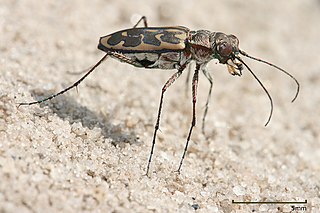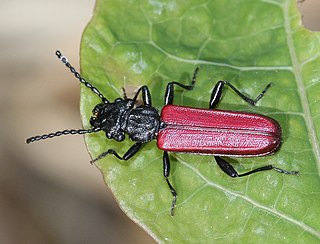Related Research Articles

The Japanese beetle is a species of scarab beetle. The adult measures 15 mm (0.6 in) in length and 10 mm (0.4 in) in width, has iridescent copper-colored elytra and a green thorax and head. It is not very destructive in Japan, where it is controlled by natural predators, but in North America, it is a noted pest of about 300 species of plants including rose bushes, grapes, hops, canna, crape myrtles, birch trees, linden trees, and others.

Tiger beetles are a large group of beetles, from the Cicindelinae subfamily, known for their aggressive predatory habits and running speed. The fastest known species of tiger beetle, Rivacindela hudsoni, can run at a speed of 9 km/h, or about 125 body lengths per second. As of 2005, about 2,600 species and subspecies were known, with the richest diversity in the Oriental (Indo-Malayan) region, followed by the Neotropics.

The rove beetles are a family (Staphylinidae) of beetles, primarily distinguished by their short elytra that typically leave more than half of their abdominal segments exposed. With roughly 63,000 species in thousands of genera, the group is currently recognized as the largest extant family of organisms. It is an ancient group, with fossilized rove beetles known from the Triassic, 200 million years ago, and possibly even earlier if the genus Leehermania proves to be a member of this family. They are an ecologically and morphologically diverse group of beetles, and commonly encountered in terrestrial ecosystems.

Amphizoa is a genus of aquatic beetles in the suborder Adephaga, placed in its own monogeneric family, Amphizoidae. There are five known species of Amphizoa, three in western North America and two in eastern palearctic. They are sometimes referred to by the common name troutstream beetles.

The Cucujidae, "flat bark beetles," are a family of distinctively flat beetles found worldwide under the bark of dead trees. The family has received considerable taxonomic attention in recent years and now consists of 59 species distributed in four genera. It was indicated Cucujus species are scavengers, only feeding on pupae and larvae of other insects and on other subcortical beetles such as their own. Since the Cucujidae prey on larvae of potentially tree damaging beetles that spread fungal diseases, they are considered to be beneficial to the health of living trees.

Dermestidae are a family of Coleoptera that are commonly referred to as skin beetles. Other common names include larder beetle, hide or leather beetles, carpet beetles, and khapra beetles. There are approximately 500 to 700 species worldwide. They can range in size from 1 to 12 mm. Key characteristics for adults are round oval shaped bodies covered in scales or setae. The usually clubbed antennae fit into deep grooves. The hind femora also fit into recesses of the coxa. Larvae are scarabaeiform and also have setae.

The Japanese rhinoceros beetle, Japanese horned beetle, or kabutomushi (カブトムシ), Allomyrina dichotoma, is a species of rhinoceros beetle.

The tiger shrike or thick-billed shrike is a small passerine bird which belongs to the genus Lanius in the shrike family, Laniidae. It is found in wooded habitats across eastern Asia. It is a shy, often solitary bird which is less conspicuous than most other shrikes. Like other shrikes it is predatory, feeding on small animals. Its nest is built in a tree and three to six eggs are laid.

Phyllophaga is a very large genus of New World scarab beetles in the subfamily Melolonthinae. Common names for this genus and many other related genera in the subfamily Melolonthinae are May beetles, June bugs, and June beetles. They range in size from 12 to 35 mm and are blackish or reddish-brown in colour, without prominent markings, and often rather hairy ventrally. These beetles are nocturnal, coming to lights in great numbers.

Carabus violaceus, sometimes called the violet ground beetle, or the rain beetle is a nocturnal species of a beetle, from the family Carabidae.

Lasius fuliginosus, also known as the jet ant or jet black ant, is a species of ant in the subfamily Formicinae. Workers have a black shiny colour and a length of about 4–6 mm, females are larger (6–6.5 mm) and small males reach a length of 4.5–5 mm). The head is heart-shaped.
Trephionus is a genus of beetles in the family Carabidae, containing the following species: Five new species were described in 2018 from Japan.
Trephionus kinoshitai, is a species of beetle belonging to the family Carabidae. It is endemic to Japan.
Trephionus cylindriphallus, is a species of beetle belonging to the family Carabidae. It is endemic to Japan.
Trephionus niumontanus, is a species of beetle belonging to the family Carabidae. It is endemic to Japan.
Trephionus babai, is a species of beetle belonging to the family Carabidae. It is endemic to Japan.
Trephionus shibataianus, is a species of beetle belonging to the family Carabidae. It is endemic to Japan.
Trephionus inexpectatus, is a species of beetle belonging to the family Carabidae. It is endemic to Japan.
Trephionus bifidilobatus, is a species of beetle belonging to the family Carabidae. It is endemic to Japan.
References
- 1 2 3 Sasakawa, K.; Itô, H. (2018). "Taxonomic notes on the ground beetles in the genus Trephionus Bates, 1883 from central Honshu, Japan". ZooKeys (742): 91–104. doi: 10.3897/zookeys.742.23752 . PMC 5904455 . PMID 29670432 . Retrieved 3 April 2018.